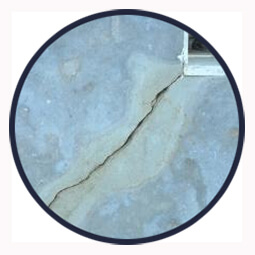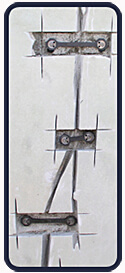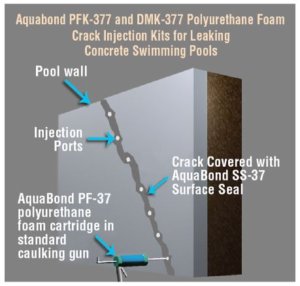How To Repair Inground Pool Floor
Fixing Pond Pool Cracks
 Cracks in your inground pool? Scary, I know. Cracks in a gunite or concrete pool can conjure upwards all sorts of fears of much worse things. In most cases, puddle cracks do non go along to cleft, and tin be permanently repaired.
Cracks in your inground pool? Scary, I know. Cracks in a gunite or concrete pool can conjure upwards all sorts of fears of much worse things. In most cases, puddle cracks do non go along to cleft, and tin be permanently repaired.
Allow me to make a distinction between surface crazing, or cheque-cracks in the plaster – and cracks that run through the pool trounce. Information technology'southward not uncommon for plastered pools to develop small, hairline cracks in the surface of the plaster, especially close to the surface, on the top steps for instance.
Cracks that run deeper tin exist seen in the corners, or where a spa wall joins the pool wall, or may develop behind the tile line, in the bond beam of the puddle.
Today's mail service is all about How to Repair Cracks in an Inground Pool , in three ways – the easy way, moderately difficult, and extreme crevice repair. The level of difficulty for puddle crack repair likewise tends to lucifer the level of permanence. The more work y'all put into repairing a pool crack tends to correspond to the longevity and permanence of the repair.
Easy Pool Crack Repair
 For pocket-sized cracks, the easiest repair you can do is to jump in the pool with a mask and a flathead screwdriver. Scrape the screwdriver down the crack to remove whatever loose material, and widen the crack a little bit. Employ a stiff brush to remove whatsoever dirt, oils or algae on the bonding surfaces.
For pocket-sized cracks, the easiest repair you can do is to jump in the pool with a mask and a flathead screwdriver. Scrape the screwdriver down the crack to remove whatever loose material, and widen the crack a little bit. Employ a stiff brush to remove whatsoever dirt, oils or algae on the bonding surfaces.
Adjacent, mix upward some Pool Putty in equal parts and roll information technology into a 'ophidian' with your hands. Button the putty into the crack and polish information technology out with your hand.
Moderate Pool Crack Repair
For a moderately difficult crevice repair, merely one with more permanence and more likely to friction match the plaster color better, start by draining the pool.
Avoid draining the pool later heavy rains, and be sure to pump the puddle to a far away location, to be sure the water doesn't run underneath the pool. In pools that are located in a topographical depression, or with a high water tabular array, hydrostatic pressure could possibly pop the pool out of the ground.
 Once the pool is drained, find your hydrostatic relief plugs plastered into the floor. Chip away the plaster within of the plug, and then you can grab it with direct pliers and unthread the hydrostat plug. Well-nigh pools have 4-6 of these floor plugs. Open up upwards at to the lowest degree 2 of them – just in case.
Once the pool is drained, find your hydrostatic relief plugs plastered into the floor. Chip away the plaster within of the plug, and then you can grab it with direct pliers and unthread the hydrostat plug. Well-nigh pools have 4-6 of these floor plugs. Open up upwards at to the lowest degree 2 of them – just in case.
 Side by side, widen the cleft using a 4 inch grinder. If the crack is small enough, you tin also use a drill with a masonry drill bit. You can rent these at any rental store. Wearable middle and ear protection, heavy gloves, boots and long pants. It will get dusty, so a dust mask is also a good idea. Apply care if y'all use a grinder, they are very dangerous and can hands lop off a finger, or cut a deep gash in your leg if it gets away from you.
Side by side, widen the cleft using a 4 inch grinder. If the crack is small enough, you tin also use a drill with a masonry drill bit. You can rent these at any rental store. Wearable middle and ear protection, heavy gloves, boots and long pants. It will get dusty, so a dust mask is also a good idea. Apply care if y'all use a grinder, they are very dangerous and can hands lop off a finger, or cut a deep gash in your leg if it gets away from you.
 As you widen the crack, employ the grinder or drill to 'dovetail' the crack, which ways to cut information technology at an angle, to create a reverse 'V' in the plaster, and into the physical beneath.
As you widen the crack, employ the grinder or drill to 'dovetail' the crack, which ways to cut information technology at an angle, to create a reverse 'V' in the plaster, and into the physical beneath.
A dovetail cutting volition meliorate the success of the repair, every bit information technology will hold in your patching material much better than a simple 'V' cut.
Later on you have made your cuts, clean out the cleft with a garden hose, to remove any loose material and grit.
 Now you can mix up a small-scale batch of pool plaster mix – EZ Patch #1, to fill in the fissure. If your crack is over one″ deep, or for replacing large chunks of the pool wall, first employ a hydraulic cement, from any hardware store, to fill up in most of the area, but leave the superlative ane/2 inch or so, to cover over with plaster mix.
Now you can mix up a small-scale batch of pool plaster mix – EZ Patch #1, to fill in the fissure. If your crack is over one″ deep, or for replacing large chunks of the pool wall, first employ a hydraulic cement, from any hardware store, to fill up in most of the area, but leave the superlative ane/2 inch or so, to cover over with plaster mix.
Yous can as well use EZ-Patch 1-FS, a fast-gear up pool plaster mix that can exist used underwater or above water. Corking for patching cracks in the pool, or to pack into voids around skimmers, drains, lights or returns. Plaster patch is as well useful for puddle tile repair and equally a puddle tile grout replacement.
Be certain that the cleft is moist earlier you fill the crack. For the best bail, 'pigment' the cleft with a bonding additive, such equally Acryl 60, only before laying in the cement or plaster mix. For vertical fissure repair, use a slightly drier mix, to avoid slump, and cheque on information technology every few minutes – it may need a 'trowel-up' with a wet trowel.
After the crevice has been filled with plaster, it's important to keep the area moist, to prevent the mix from drying out as well rapidly. Lay a moisture towel or burlap over the area to keep moisture in, and spray it with h2o twice a day, until the pool is refilled. You lot can also tape plastic over the expanse, with a few pocket-size air holes every few inches.
Plaster repair mix is meant to cure underwater, so you lot tin begin to fill the pool immediately afterward you exit the pool.
Extreme Pool Crack Repair
At that place was a pool that I managed in McLean, Va that was built on a hillside, overlooking a scenic stream. Years of pitter-patter on the hillside beyond had cracked the pool right beyond the flooring, and it was visibly tilted – this pool was literally cracked in half.
STAPLES
 For cracks in the pool that run downwardly the wall and across the floor of the puddle, a more agressive arroyo to crack repair is necessary, using 'staples'.
For cracks in the pool that run downwardly the wall and across the floor of the puddle, a more agressive arroyo to crack repair is necessary, using 'staples'.
In this crack repair, all of the 'moderate' crevice repair steps above are performed with one unique deviation. Every foot or so, a horizontal cut is fabricated perpendicular to the scissure, holes are drilled on either side, and a steel or carbon fiber 'staple' is epoxied in place.
This method locks the puddle wall together on both sides of the scissure, like a frankenstein stitch. Several companies produce these staples, with the main supplier being TorqueLock. The staples used on pool cracks are generally about 6 inches wide. Later on the staples are set in place, the holes are covered up with plaster, or the entire puddle can be re-plastered or painted.
This arroyo is not needed for most pool cracks, which are not structural, and those for which futurity movement is not a concern. Notwithstanding, information technology volition provide the best and almost permanent repair to large, widespread pool cracking.
EXOXY INJECTION
Some other method ofextreme pool crack repair fills the entire crack all the way through the pool beat out, and not merely on the surface. Epoxy sealant or Urethane cream is shot into the crack nether pressure level, to fill every void from front to back.
 Epoxy injection may be used forth with staples for the best mode to patch pool cracks. Companies like Aquabond Adhesives take created a kit that is easy to use to repair minor cracks. Information technology's a more involved repair considering you have to install injection ports along the crack which are sealed into place, to allow the urethane cream to completely fill the scissure and bond tightly to surfaces.
Epoxy injection may be used forth with staples for the best mode to patch pool cracks. Companies like Aquabond Adhesives take created a kit that is easy to use to repair minor cracks. Information technology's a more involved repair considering you have to install injection ports along the crack which are sealed into place, to allow the urethane cream to completely fill the scissure and bond tightly to surfaces.
First widen the fissure, clean the surfaces and remove any loose material. And so utilize the modified epoxy paste to cover the entire crevice, securing the injection ports every foot along the fissure. When the paste hardens, you affluent the crack with h2o and then inject the ports with the expanding epoxy cream until it flows out freely. One time dry out, grind off the injection ports and the surface seal affluent to the surface.
So now that you know what to do – it's time to get cracking! On some swimming puddle scissure repair, that is! If you accept any questions, detect my electronic mail at the peak of the page, send me pictures of your pool cracks!
Oh, and most cracks only demand the easy and moderate solutions shown above, very few puddle cracks will demand staples or injection repairs. Beam harm, where the pool crevice is running horizontally behind the tile line, is another blazon of cracking.
Source: https://blog.intheswim.com/how-to-fix-swimming-pool-cracks/

0 Response to "How To Repair Inground Pool Floor"
Post a Comment